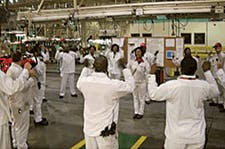Music blares from the overhead speakers as the first shift files in for the day's work.
For two minutes, employees exercise together, working their hands, their shoulders.
Every day, like clockwork, this ritual occurs.
Before the daily production meetings.
Before the lines begin to run.
Every day, Honda of South Carolina's manufacturing facility reverberates with the beat of the music.
The exercise, Wendell Hughes, manager of environmental, health and safety for Honda of South Carolina, says, serves as a warmup for employees getting ready for their shifts.
Much like runners stretch before a race, moderate exercise readies workers for the intense pace of the production floor.
With Honda operating with 52-second process times, the risk for ergonomic injuries is high.
Yet, this Honda plant hasn't recorded an ergonomic injury in two years, a success Hughes partially attributes to the morning exercise.
"It's just a great way to start the morning off," says Hughes, who introduced the idea after seeing it in action at one of the company's Japanese facilities. "We've spent zero dollars on ergonomic injuries in two years."
The morning workout is just one part of Honda's workplace wellness strategy.
"Wellness, it just makes sense," says Hughes. "If our associates aren't healthy, it's going to be difficult to produce a quality product."
The Pursuit of Wellness
Ultimately, there are two reasons why companies develop wellness programs: to improve worker performance or to cut down on healthcare and lost productivity costs, according to Ronald J. Burke, Kathryn M. Page and Cary L. Cooper, authors of "Flourishing in Life, Work and Careers: Individual Wellbeing and Career Experiences."
Indeed, keeping employees healthy, Hughes says, is designed to cut down on health insurance costs and help the company to be more efficient.
"We saw health insurance rising every year and we knew we had to do something to curb that number downward," Hughes says.
A report by the RAND Corp. found that more than half of all employers with more than 50 employees offer some form of wellness program "out of concern about the impact of chronic disease on employee health and well-being, the cost of health care coverage and competitiveness." Larger employers, the study found, are more likely to have more complex programs.
While some wellness initiatives show immediate payoffs, others take longer to generate results.
Honda last year introduced a points-based health insurance plan to its 1,000 associates. Under the plan, employees need to earn 175 wellness points to avoid paying an additional $100 biweekly for insurance.
In its first year of adoption, 83 percent of the site's workforce participated. This year, the participation is trending in the upper 90s.
Under the plan, the site's insurance costs initially have gone up, but Hughes expects to see those numbers reverse course in due time.
"We're encouraging everyone to go to the doctor, so there's an initial hump," says Hughes.
The company encourages employees to earn points by scheduling health, vision and dental appointments; attending lunch and learn wellness sessions; and participating in its Walking Works program, company Relay for Life Team or its annual Turkey Run, among other activities.
And it promotes those wellness activities via weekly newsletters, TVs in the cafeteria and in messages added to paychecks.
Honda also is considering offering special wellness incentives, including wellness points and a free gym membership, to its 15-person volunteer fire brigade to encourage members to remain healthy.
"We definitely can see the benefit of keeping the fire brigade members healthy," Hughes says, noting the high risk of heart attacks for firefighters.
One Step at a Time
Workplace wellness, however, is not an overnight undertaking.
Rather, it's a slow process, says Dr. Chris Meletis, a naturopathic doctor and former dean and chief medical officer of the National College of Natural Medicine.
"Every step in the right direction is good," Meletis says.
With companies focused on ROI, justifying putting time and effort into wellness efforts can be a challenge. But encouraging healthy behavior in even the smallest ways pays off.
According to the RAND study, those who participate in a wellness program show "significant and clinically meaningful improvements in exercise frequency, smoking behavior and weight control" compared to those who do not.
"Focus on simple things that allow people to be more productive," Meletis says.
He offers the following workplace wellness tips:
- Have walking meetings. Get employees up and moving while still being productive.
- Encourage employees to pack their lunch so that they choose healthier options from home.
- Offer apples and other fresh produce to employees on site.
About the Author
Ginger Christ
Associate Editor
Ginger Christ is an associate editor for EHS Today, a Penton publication.
She has covered business news for the past seven years, working at daily and weekly newspapers and magazines in Ohio, including the Dayton Business Journal and Crain’s Cleveland Business.
Most recently, she covered transportation and leadership for IndustryWeek, a sister publication to EHS Today.
She holds a bachelor of arts in English and in Film Studies from the University of Pittsburgh.


